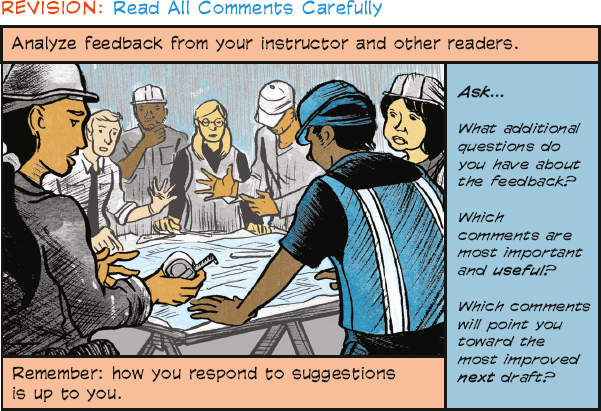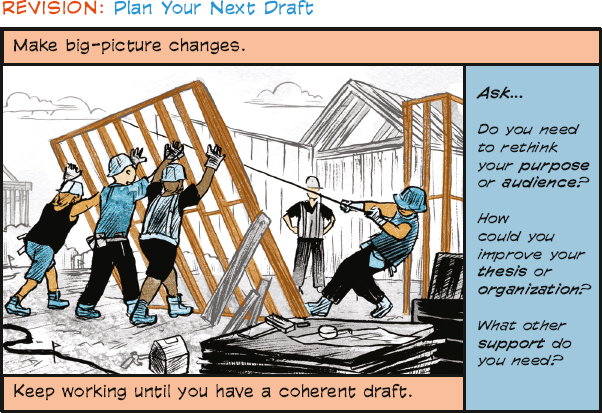10dRevise.
Approach comments from peer reviewers or from your instructor in several stages. First, read straight through the comments. Take a few minutes to digest the feedback and get some distance from your work. Then make a revision plan—as elaborate or as simple as you want—that prioritizes the changes needed in your next draft.

Go to the Thinking Visually exercise to analyze this image
If you have comments from more than one reviewer, you may want to begin by making two lists: (1) areas in which reviewers agree on needed changes, and (2) areas in which they disagree. You will then have to make choices about which advice to heed and which to ignore from both lists. Next, rank the suggestions you’ve chosen to address.
Focus on comments about your purpose, audience, stance, thesis, and support. Leave any changes to sentences, words, punctuation, and format for later in the process; your revision of bigger-picture issues comes first.
Prepare a file for your revised draft. Use your previous draft as a starting point, renaming it to indicate that it is a revision. (For example, Javier Jabari might rename his file jabari essay1 d2, using his name, assignment number, and draft number.)
In the new file, make the changes you identified in your revision plan. Be prepared to revise heavily, if necessary; if comments suggest that your thesis isn’t working, for example, you may need to change the topic or the entire direction of your text. Heavy revision is not a sign that there’s something wrong with your writing; on the contrary, major revision is a common feature of serious, goal-oriented writing.
Once you are satisfied that your revisions adequately address major concerns, make corrections to sentences, words, and punctuation.
Thesis
Make sure that your thesis states the topic clearly and comments on what is particularly significant about the topic (7b). In addition, ask yourself whether the thesis is narrowed and focused enough to be thoroughly proven. If not, take time now to refine or limit your thesis further.
When you revise your thesis, remember also to revise the rest of the draft accordingly.

Go to the Thinking Visually exercise to analyze this image
Support
Make sure that each paragraph relates to or supports the thesis and that each paragraph has sufficient detail to support the point it is making. Eliminate unnecessary material, and identify sections that need further details or examples.
Organization
Should any sections or paragraphs be moved to clarify your point or support your thesis more logically? Are there any paragraphs or parts of paragraphs that don’t fit with the essay now or that are unnecessary? Look for confusing leaps or omissions, and identify places where transitions would make the writing easier to follow.
Title, introduction, and conclusion
Does the title give information and draw readers in? Does the introduction attract their interest and present the topic in a way that makes them want to keep reading? Does the conclusion leave readers satisfied? Because readers notice beginnings and endings more than other parts of a piece of writing, pay special attention to how you introduce and conclude your work.
Visuals, media, and design
As you check what you’ve written about your topic, you also need to take a close look at the way your text looks and works. Do your visuals, audio, and video (if any) help you make your points? How can you make this content more effective? Do you use design effectively for your genre and medium? Is your text readable and inviting?
Revision
TALKING THE TALK
Revision
“I thought I had revised my assignment, but my instructor said I’d just corrected the typos.” It’s always a good idea to clarify what revision means with a particular instructor. Generally, though, when a writing teacher asks for a revision, minor corrections will not be enough. Plan to review your entire draft, and be prepared to make major changes if necessary. Look for sentence-level errors and typos later, during the editing stage, since these may disappear or change as you revise.
Watch and respond to the video Revision Happens.
Watch and respond to the video It's hard to delete things.